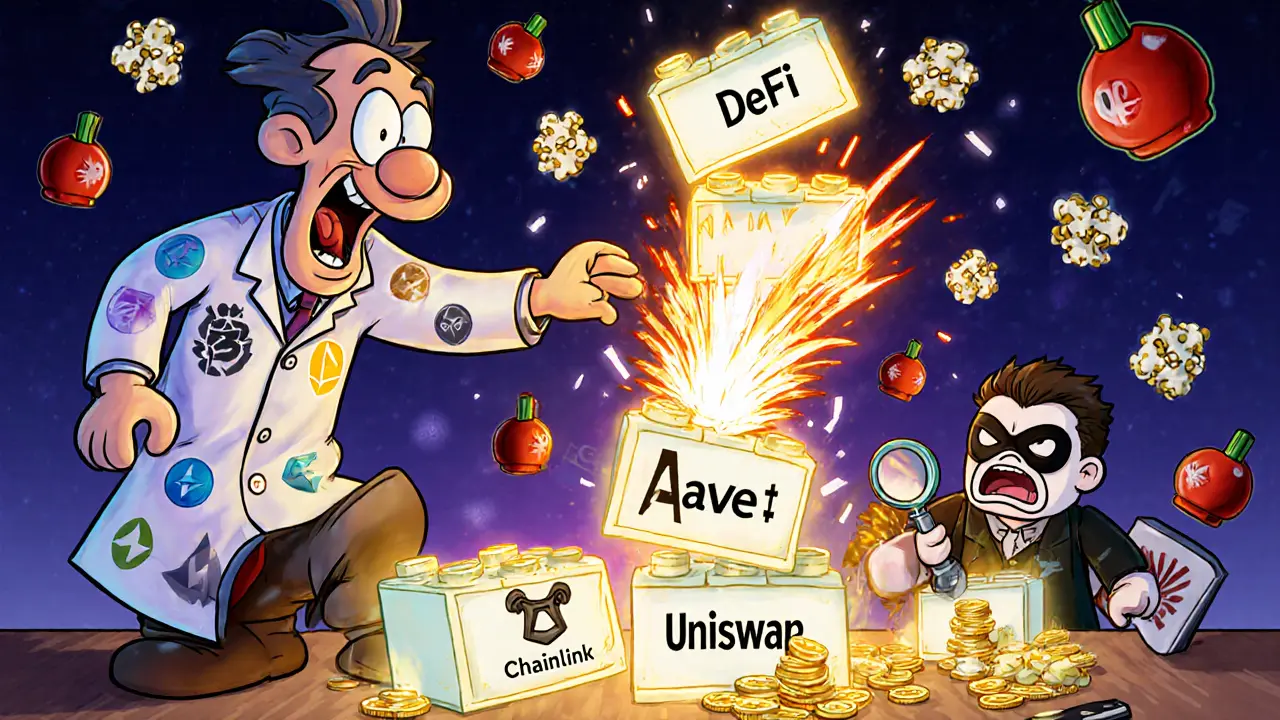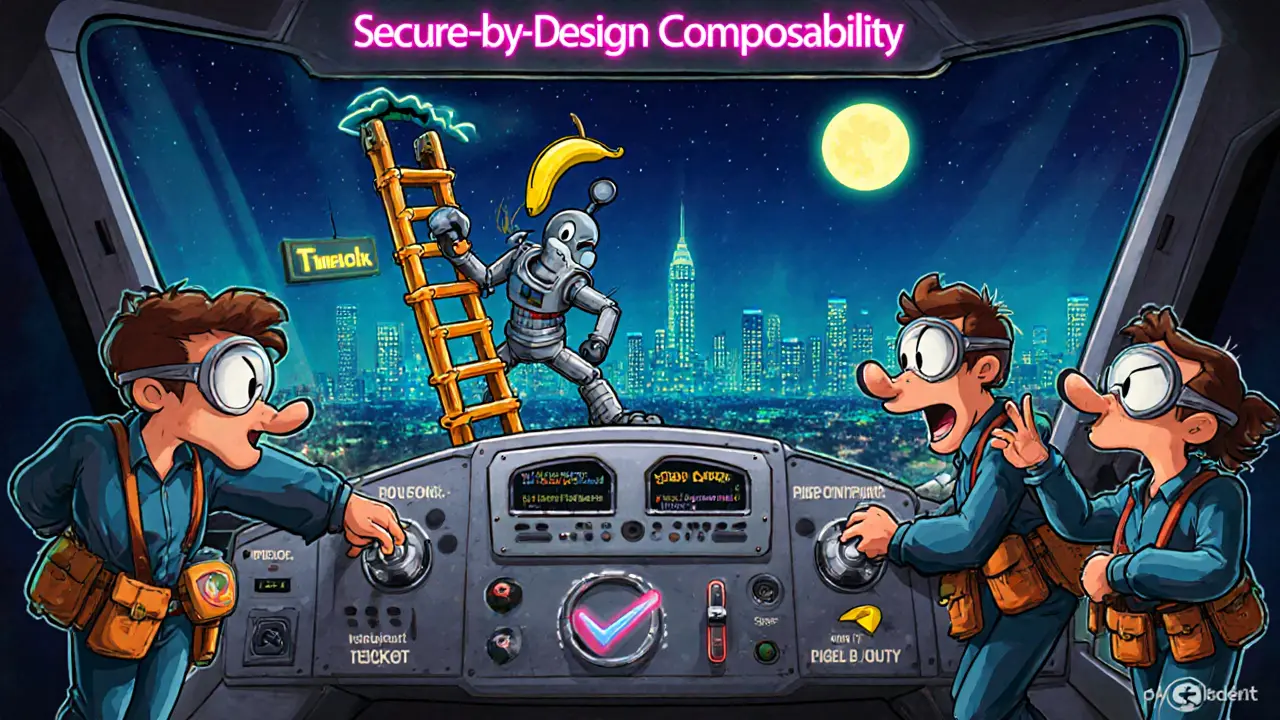Composability vs Security Trade-offs in Blockchain Systems
 Sep, 27 2025
Sep, 27 2025
Composability Risk Calculator
Estimate Your Project's Security Risk
This tool helps quantify security risks introduced by composability in blockchain projects. Enter your project's details to get a risk assessment and mitigation recommendations.
When you build a blockchain application, you don’t start from scratch. You pull in existing smart contracts, reuse wallet libraries, connect to oracles, and plug into decentralized exchanges. That’s composability-the ability to stack pieces of code like Lego blocks. It’s why DeFi exploded so fast. But every time you add a new piece, you also add a new way for attackers to break in.
What Composability Really Means in Blockchain
Composability isn’t just a buzzword. It’s the core reason you can take a lending protocol like Aave, connect it to a decentralized exchange like Uniswap, and use the borrowed ETH as collateral to mint a stablecoin on MakerDAO-all in one transaction. Each of those protocols is a standalone module, built by different teams, with different security models. But they talk to each other through open interfaces. That’s the power.It’s not just DeFi. NFT marketplaces now pull in royalty engines from third parties. Gaming economies use token standards from other chains. Even identity systems are being stitched together using verifiable credentials from multiple sources. The result? Faster innovation, lower development costs, and features that would take years to build alone.
But here’s the catch: each connection point is a potential entry point for hackers. A flaw in one contract can ripple through the whole system. That’s why the same feature that makes blockchain so powerful also makes it fragile.
Why Security Gets Harder with More Parts
In a monolithic system-like a traditional bank’s backend-security is simpler. You have one codebase. One firewall. One team watching the logs. You update once, test once, patch once.In a composable blockchain system, you have dozens of moving parts. Each smart contract has its own access controls. Each external call-like fetching price data from Chainlink-creates a trust boundary. Every time a contract calls another, it’s like handing a key to a stranger and hoping they don’t misuse it.
Attackers don’t need to break the strongest contract. They just need to find the weakest link. The 2022 Ronin Bridge hack didn’t target the bridge itself. They compromised a single validator node that had too much trust. That one weakness unlocked $625 million. In a composable world, that’s not an anomaly-it’s a pattern.
API sprawl is another silent killer. When you have 15 contracts calling 8 different oracles, 3 identity providers, and 2 liquidity pools, tracking who can do what becomes a nightmare. Permissions get misconfigured. Roles overlap. Old contracts keep running even after they’re deprecated. And no one notices until it’s too late.
The Hidden Costs of Speed
The biggest driver of composability is speed. Teams can ship features in days, not months. Startups can launch products that feel like they’ve been around for years. Investors love it. Users love it.But speed comes at a price. Most teams rush to integrate. They copy-paste code from GitHub. They assume “if it works on testnet, it’s fine.” They skip audits because “we’re just a prototype.” Then they go live. And when the attack comes, they’re not ready.
According to a 2024 report by CertiK, over 60% of DeFi exploits in the last two years were caused by integration flaws-not core contract bugs. That means the code itself was fine. But the way it was connected? Broken.
Compare that to a monolithic system. You move slower. You test everything. You have one team owning the whole stack. It’s less exciting. But it’s safer.

When Composability Wins-Even With Risk
That doesn’t mean you should avoid composability. It means you need to manage it.Some use cases demand it. Think of a DeFi aggregator like 1inch or ParaSwap. They don’t own liquidity. They don’t run exchanges. They just route trades across dozens of protocols. Without composability, they wouldn’t exist. Their value is in the connections.
Same with yield optimizers. Yearn Finance doesn’t create new lending markets. It moves your funds between Aave, Compound, and Curve to find the best return. That’s only possible because those protocols speak the same language.
These systems don’t eliminate risk-they contain it. They use:
- Reentrancy guards to stop recursive attacks
- Access control lists to limit who can call critical functions
- On-chain monitoring to flag unusual transaction patterns
- Time delays on large withdrawals
They also rely on third-party audits, bug bounties, and community scrutiny. The more eyes on the code, the less likely a hidden flaw survives.
How to Build Securely Without Sacrificing Composability
You can’t stop composability. It’s too valuable. But you can make it safer.Here’s how real teams are doing it in 2025:
- Start with a minimal interface. Only expose what’s absolutely necessary. Hide internal logic. Don’t let external contracts call functions you don’t control.
- Use standardized patterns. ERC-4626 for vaults, ERC-721A for NFTs, OpenZeppelin’s secure libraries. Don’t reinvent the wheel-especially if it’s a wheel with cracks.
- Enforce strict input validation. Never trust data from another contract. Even if it’s from a trusted source. Always check ranges, types, and limits.
- Deploy with delay. Use timelocks for upgrades. Even if you’re confident, wait 48 hours before activating changes. Give the community time to react.
- Monitor everything. Set up alerts for unusual contract calls. Track gas usage spikes. Watch for new wallets interacting with your contracts. Tools like Tenderly and BlockSec can flag anomalies before they become exploits.
And don’t skip audits-but don’t rely on them either. A single audit is a snapshot. Your system changes every day. Continuous monitoring is the real security layer.

The Future: Secure-by-Design Composability
The industry is catching on. New tools are emerging that bake security into the composability layer.Projects like Zero-Knowledge Proofs for Interoperability let contracts verify data from other chains without trusting them. Policy engines like OZ’s Access Control Manager let you define rules once and apply them across all connected contracts. Automated formal verification tools now check for common vulnerabilities before code even deploys.
And the biggest shift? Teams are starting to treat security as a design constraint-not an afterthought. They ask: “If this contract breaks, what’s the worst that happens?” before writing a single line of code.
That’s the future. Not less composability. More intelligent composability.
Final Reality Check
Composability isn’t evil. Security isn’t the enemy. The enemy is ignorance.If you’re building on blockchain and you’re not thinking about how your contracts interact with others-you’re playing Russian roulette with user funds. Every integration is a gamble. Some pay off. Others wipe out millions.
The smart builders don’t avoid connections. They choose them carefully. They test them obsessively. They assume the worst. And they plan for failure.
That’s not just good engineering. It’s the only way to build something that lasts.
Is composability unique to blockchain?
No, composability exists in traditional software too-like using APIs to connect payment processors, email services, or cloud storage. But blockchain takes it further. Because smart contracts are public, immutable, and permissionless, anyone can interact with them without asking. That makes composability more powerful-and more dangerous-than in centralized systems.
Can you have both high composability and high security?
Yes-but only with deliberate design. It’s not automatic. You need standardized interfaces, strict access controls, continuous monitoring, and a culture that treats security as part of development-not a final checklist. Projects like MakerDAO and Aave have proven it’s possible, but they spent years refining their architecture and responding to attacks.
What’s the biggest mistake teams make with composability?
Assuming that if a contract is popular or audited, it’s safe. Many hacks happen because a team trusted a well-known library or oracle without checking how it was being used. A contract can be secure on its own but become vulnerable when connected to something else. Always test the integration, not just the pieces.
Do I need a security team to use composability?
You don’t need a big team, but you do need someone who understands distributed systems and smart contract risks. At minimum, assign one person to own security for your project. They don’t need to be a cryptographer-but they need to know how to read audit reports, set up alerts, and question every external call.
Are there tools that help automate security in composable systems?
Yes. Tools like Slither and MythX scan Solidity code for vulnerabilities. Tenderly and BlockSec monitor live contracts for suspicious activity. OpenZeppelin Defender lets you set up automated transaction guards. And newer platforms like Foundry include built-in fuzz testing that simulates malicious interactions between contracts. These tools won’t replace human judgment, but they catch the mistakes most teams miss.
Rampraveen Rani
September 27, 2025 AT 07:24Ashley Cecil
September 27, 2025 AT 07:25Joseph Eckelkamp
September 27, 2025 AT 07:26Jennifer Rosada
September 27, 2025 AT 07:28adam pop
September 27, 2025 AT 07:30Shruti rana Rana
September 27, 2025 AT 07:31Chris Houser
September 27, 2025 AT 07:33John E Owren
September 27, 2025 AT 07:35LeAnn Dolly-Powell
September 27, 2025 AT 07:36Anastasia Alamanou
September 27, 2025 AT 07:38Brody Dixon
September 27, 2025 AT 07:40Santosh harnaval
September 27, 2025 AT 07:41Steve Roberts
September 27, 2025 AT 07:43John Dixon
September 27, 2025 AT 07:45Dimitri Breiner
September 27, 2025 AT 07:46Claymore girl Claymoreanime
September 27, 2025 AT 07:48Petrina Baldwin
September 27, 2025 AT 07:50